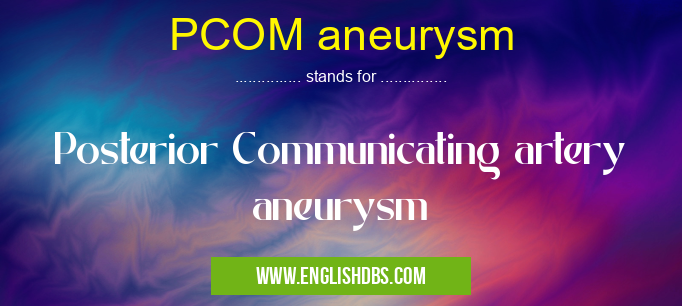What does PCOM ANEURYSM mean in MEDICAL
A Posterior Communicating artery aneurysm or PCOM aneurysm is a dilation or ballooning of the posterior communicating artery, which is a blood vessel that connects the internal carotid artery to the posterior cerebral artery. PCOM aneurysms are a type of intracranial aneurysm, which means they occur within the skull.

PCOM aneurysm meaning in Medical in Medical
PCOM aneurysm mostly used in an acronym Medical in Category Medical that means Posterior Communicating artery aneurysm
Shorthand: PCOM aneurysm,
Full Form: Posterior Communicating artery aneurysm
For more information of "Posterior Communicating artery aneurysm", see the section below.
Causes
The exact cause of PCOM aneurysms is unknown, but there are several risk factors that can increase the likelihood of developing one, including:
- Age: PCOM aneurysms are more common in people over the age of 50.
- Smoking: Smoking is a major risk factor for PCOM aneurysms.
- High blood pressure: High blood pressure can weaken the walls of blood vessels, making them more susceptible to aneurysms.
- Family history: People with a family history of PCOM aneurysms are at an increased risk of developing one themselves.
- Certain medical conditions: Certain medical conditions, such as fibromuscular dysplasia and Ehlers-Danlos syndrome, can weaken the walls of blood vessels and increase the risk of aneurysms.
Symptoms
Most PCOM aneurysms do not cause any symptoms. However, if the aneurysm is large enough, it can press on nearby structures, such as the optic nerve or the brain stem. This can cause symptoms such as:
- Headache
- Nausea and vomiting
- Vision problems
- Weakness or numbness on one side of the body
- Difficulty speaking or swallowing
Diagnosis
PCOM aneurysms are typically diagnosed through imaging tests, such as a CT scan or an MRI scan. These tests can show the size and location of the aneurysm.
Treatment
The treatment for a PCOM aneurysm depends on its size and location. Small aneurysms that are not causing any symptoms may not require treatment. However, larger aneurysms or aneurysms that are causing symptoms will need to be treated to prevent rupture. Treatment options include:
- Surgical clipping: This involves placing a small metal clip around the neck of the aneurysm to prevent blood flow into it.
- Endovascular coiling: This involves inserting a catheter into the aneurysm and filling it with coils to block blood flow.
- Flow diversion: This involves placing a stent in the parent artery to divert blood flow away from the aneurysm.
Essential Questions and Answers on Posterior Communicating artery aneurysm in "MEDICAL»MEDICAL"
What is a PCOM aneurysm?
A PCOM aneurysm (Posterior Communicating artery aneurysm) is a localized, blood-filled bulge that forms in the posterior communicating artery, a small vessel that connects the internal carotid artery to the posterior cerebral artery in the brain.
What causes a PCOM aneurysm?
The exact causes of PCOM aneurysms are not fully understood, but several factors are associated with their development, including high blood pressure, smoking, family history of aneurysms, and certain medical conditions like atherosclerosis and fibromuscular dysplasia.
What are the symptoms of a PCOM aneurysm?
Small PCOM aneurysms often do not cause any symptoms. However, larger aneurysms can put pressure on surrounding brain structures, leading to symptoms such as headaches, nausea, vomiting, blurred vision, and weakness or numbness on one side of the body.
How is a PCOM aneurysm diagnosed?
PCOM aneurysms are typically diagnosed through imaging tests such as CT scans or magnetic resonance imaging (MRI). These tests can visualize the aneurysm and assess its size and location.
What are the treatment options for a PCOM aneurysm?
Treatment options for a PCOM aneurysm depend on its size, location, and the patient's overall health. Treatment may involve surgical clipping or endovascular coiling, which involves inserting a tiny coil into the aneurysm to block blood flow.
Final Words: PCOM aneurysms are a serious condition, but they can be treated successfully if they are diagnosed and treated early. If you have any of the symptoms of a PCOM aneurysm, it is important to see a doctor right away.
PCOM aneurysm also stands for: |
|
| All stands for PCOM aneurysm |
